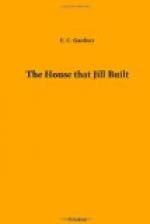Jill hardly needed this parting admonition, but listened to it and to much more good advice with the respect due to one who, for nearly half a century, had looked well to the ways of her household, whose helping hands were always outstretched to the poor and needy, whose children rose up and called her blessed, and whose husband had never ceased to praise her. After her departure her niece indulged in a short season of solemn reflection, striving faithfully to attain to that wisdom which always knows when to protest against existing circumstances and when to accept them with equanimity. Ultimately she reached the conclusion that, while the house that Jack built might indeed be a thoroughly comfortable home to one who had a contented mind, it was really her duty in her probationary housekeeping to be as critical as possible.
Among other things the doors came in for a share of her usually amiable denunciation. She declared they were huge and heavy enough in appearance for prison cells, yet so loosely put together that their prolonged existence seemed to be a question of glue. They were swollen in the damp, warm weather till they refused to be shut, and would doubtless shrink so much under the influence of furnace heat in the winter that they would refuse to stay shut. The closet doors swung against the windows, excluding instead of admitting the light. The doors of the chambers opened squarely upon the beds, and there seemed to have been no thought of convenient wall spaces for pictures and furniture.
[Illustration: OUTSIDE BARRIERS.]
The architect’s theory of doors, as expounded in one of his letters, was simple enough: “Outside doors are barricades; they should be solid and strong in fact and in appearance. Inner doors, from room to room, require no special strength; they should turn whichever way gives the freest passage and throws them most out of the way when they are open. Seclusion for the inmates is the chief service of chamber doors, and they should be placed and hung so as not to give a direct glimpse across the bed or into the room the moment they are set even slightly ajar. Closet doors are screens simply, and ought to hide the interior of the closet when they are partially open, as well as when they are closed. They may be as light as it is possible to make them. In many houses one-half the doors might wisely be sent to the auction-room and the proceeds invested in portieres, which are often far more suitable and convenient than




